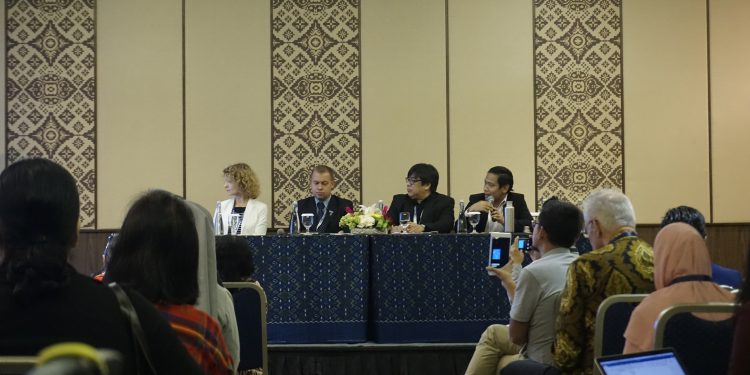Bali, Indonesia (30 October 2018). Alliance of Zero Waste Indonesia (AZWI) had the chance to hold a side event on the second day of Our Ocean Conference 2018. AZWI partnered with several organizations and governments to show the importance of preventing the usage of single-use plastics by showing facts happening in practice, toxic substances present in plastic products and packaging, and solutions that are being implemented in several cities in Indonesia.
The facts in practice show that plastic pollution has caused destruction on planet earth. Various animals have become victims of plastic pollution, which is now found throughout the environment – on land, on the coastline, on the surface of the ocean, all the way into the deep sea. Microplastics have also been found in marine life such as fish, mollusks, sea birds, sea turtles, and marine mammals. A research conducted by the World Economic Forum revealed that there will be more microplastics than planktons in the ocean by 2050. Recently, a study carried out by scientists from University of London’s Royal Holloway, The Natural History of Musem and the University of the West of Scotland shows that microplastics have been found in humans stools.
Not only that, the pollution from the toxic substances present in plastic products and packaging also cause destruction on earth. In a recent IPEN report, it is stated that chemical substances enter the marine environment through the atmosphere, waterways or direct disposal to the sea. It is estimated that 80% of marine chemical pollution comes from land. Most of the global land mass is connected to the marine ecosystem through rivers.
Nevertheless, many efforts have been conducted to solve this problem. The zero waste cities program has been initiated in several Asian countries such as Indonesia, Philippines, Malaysia, India and Vietnam. As an example, Tacloban, one of the cities in Philippines, has successfully reduced the number of waste that goes into landfills. Froilan Grate from Global Alliance for Incinerator Alternatives (GAIA) Asia Pacific states, “We have reduced the number of waste that goes into landfills from 90 tons/day to 66 tons/days and successfully increased the recycling rate from 5 tons/day to 129 tons/day.” This is a concrete proof that solutions started by the community can become a big power in solving plastic pollution in a collaborative way.

Moreover, several cities in Indonesia have begun implementing a ban on plastic bags, such as Banjarmasin, Balikpapan, and soon to follow, Bogor. “Balikpapan has been banning plastic bag usage since 3 July 2018 for providers in the modern retail sector. This is our effort in reducing plastic bag waste,” explains Suryanto, Head of The Environment Agency of Balikpapan City.
In line with the implementation of the plastic bag ban in Bogor City, which will start on 1 December 2018, the government of Bogor City is conducting a socialization to ensure the enforcement of the regulation goes smoothly. “We are incessantly conducting socializations to hold back the resistance of the people. This regulation was made to save Bogor City’s environment. This regulation will begin to be implemented in modern retails, followed by an implementation in traditional markets in 2019,” says Mayor of Bogor, Bima Arya Sugiarto.

In another chance, Tiza Mafira as Executive Director of Gerakan Indonesia Diet Kantong Plastik (Indonesia Plastic Bag Diet Movement) announced AZWI’s commitment to push 40 cities in Indonesia to ban the usage of single-use plastics, such as plastic bags, styrofoam, sachets, plastic straws, and microbeads. “For over 5 years we have taken part in preventing the leakage of 420 tons of plastic bags into the ocean, through the trial of Pay For Plastic in 2016 and the plastic bag ban implemented in Banjarmasin and Balikpapan. In 2019, we promise to prevent the leakage of 3,000 tons of plastic bags, through a plastic bag ban implemented in 5 cities that we are currently preparing together with local governments. We promise through this commitment to help Indonesia achieve 40.5% of the 2025 target to reduce marine plastic pollution.”





















